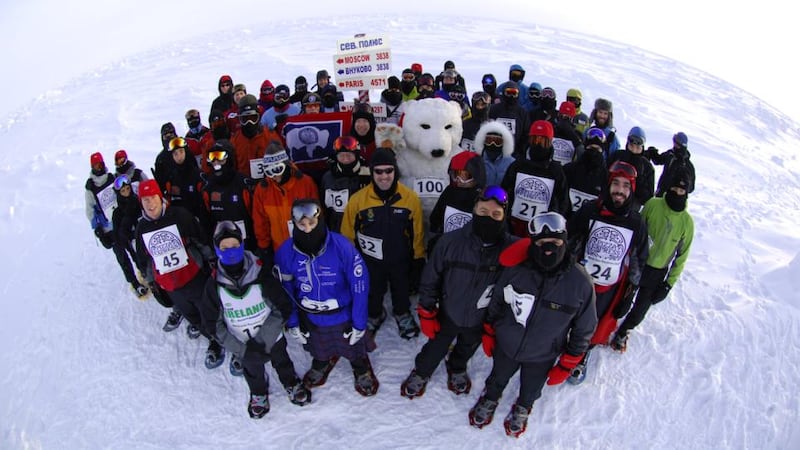Anyone who knows Richard Donovan won't be surprised to hear he has already registered domain names such as lunarmarathon.com or marsmarathon.com. Not that his wildly adventurous imagination ends there.
“Somebody had actually beaten me to moonmarathon.com,” he says. “Who knows? The North Pole Marathon seems kind of obvious now, or normal. It was a little different 12 years ago.”
Indeed, Donovan first put the North Pole Marathon on the map – excuse the pun – when, in 2002, having just completed an ultra-marathon on every continent, he decided to keep on going. In 2009 he became the first man to run seven marathons, on seven continents, in less than seven days, and since then has explored several other extreme runs including the Antarctic Ice Marathon, the Inca Trail Marathon and the Everest Challenge Marathon.

Personal favourite
The North Pole Marathon, however, remains his personal favourite – which he now organises every year. Tomorrow week, 50 runners from some 20 countries (including six from Ireland) will take part in the 12th edition of the race.
With a suitably extreme entry fee of €11,900, this is clearly not a run for everyone, yet Donovan believes it reflects the ever-widening demand for the sort of extreme races which he describes “as survival of the farthest, not just the fittest”.
Perhaps the next stop really is the moon?
“It is all about taking on something new, a fresh extension of the joy of running,” he says. “And I can tell you this is about the least expensive means by which anyone can make it to the North Pole. I’ve worked on the logistics for 10 years now, and I’ve never advertised, anywhere, outside of the website. Everything is done online. Although 50 runners, with a support team of about 10, is about the natural limit of it.”
Donovan (46) works on this extreme running business full-time and is based in his native Galway: "It was never something I had really planned, or wanted to do. It all happened by default, rather than design. For years I worked as an economist. But just because you're good at something, it doesn't mean it's good for you.
“It was only after I’d run at the North Pole and thought to myself, ‘If I’ve figured a way to get up there, then it might just work as an event. Because there had to be like-minded people.’”
The race – or rather expedition – starts with a team of Russian pilots seeking out a suitable ice runway, then airlifting in fuel, a tractor and other camp essentials. The runners are later flown in, in two teams, from Svalbard, an archipelago off the coast of Norway. The entire expedition lasts about two weeks.
Running the marathon at the North Pole, even in -30C, actually sounds like the easy part: “Well, the course is actually floating,” explains Donovan, “like most ice does, on the sea. So you’re never exactly at the North Pole, but constantly moving. We also run it on about a 5km loop. We have to keep the course close that way because there can be breaks in the ice, or a lead, and they can extend for miles. That could actually mean we could end up having runners missing. But if you’re even 2km away from the camp, it feels like you’re a long, long way from anywhere.”
What is certain is that no one runs the North Pole Marathon to clock a personal best (last year's winner Gary Thornton, also from Galway, clocked 3:49; his best is 2:17). So who exactly are the kind of runners who look to Donovan's race?
“Funnily enough, when the economy started to dive, I found more people were looking to go on trips like this.”
They’re now coming from Australia, Brazil and China. There is a running boom, anyway. “I also think there’s a huge social element, a great camaraderie among the people who do these races. The marathon is actually an ancillary part of the trip. People are interested in the North Pole, first and foremost,” says Donovan.
Spinal cord research
Donovan says he has about "seven other events in process now" and "all with a twist" but in the meantime he is also the race director for the Irish leg of the Wings for Life World Run which, on May 4th, sees the staging, simultaneously, of 35 runs around the world, all raising funds for spinal cord injury research.
Instead of a finish line, a catch-up car will leave the start 30 minutes after the runners, and as it passes each runner they must drop out, at the distance they have managed to complete. All of which begs the question of what new running concepts are still left, especially the extreme ones?
“When I went to start a volcano marathon, I wanted to find an active one that’s hot and very high. Because that’s what appeals to people, in a perverse sort of way.
“There is the idea now of just dropping runners into some very hostile environment, such as the middle of a desert, and they have to find their own way out. That does increase the risk of problems, but that’s the direction it seems to be going.”
Entries are now open for the Wings of Life World Run which takes place
around the Ring of Kerry on the May bank holiday weekend. See wingsforlifeworldrun.com











